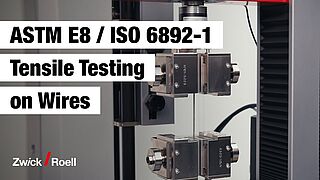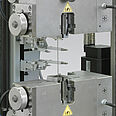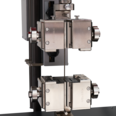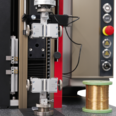Testing of Wires and Cables
The testing of wires and cables can be carried out using different tests, such as tensile tests, fatigue tests or hardness tests. The characteristic values determined from these tests are used to evaluate the load capacity of the material.
All metals can be formed into wire, which is a very common metal product. Wires are used in all areas of the manufacturing industry: in construction engineering, in electrical technology and energy technology, in aircraft and automobile manufacture, and in medical technology. Wire braided into cables is used in load-bearing applications in cable railways, elevators, cranes, bridge-building, anchorings, and fastenings. This wide range of applications means that mechanical demands are extremely varied and that testing material properties is often highly relevant to safety.
Tensile tests Hardness tests Fatigue tests Metals brochure Interesting customer projects
Wire tensile test
- Wire testing, ranging from very fine to high-strength wire, to ISO 6892 and ASTM E8 has never been this easy! Our simple application solution makes tensile testing with ZwickRoell easy, reliable and efficient.
- Even dealing with wires that are sensitive to clamping forces or high-strength wire is no longer a problem! Your specimens are securely held without the occurrence of jaw breaks and are perfectly centered via our automated alignment fixture.
- Are multiple operators running your tests? No problem! With intelligent and standard-compliant step-by-step instructions, our testXpert testing software supports the user with setup and testing, as well as in the evaluation of the test results, turning precise and repeatable test results into child's play.
Tensile tests on wire help determine material characteristic values including tensile strength or yield strength. In this context, tensile tests on wire present a challenge for the specimen grips. Wires can be very thin and at the same time of very high strength. They cannot be machined for testing, and therefore cut-off lengths are used and require suitable gripping arrangements. Simply clamping wires between jaws can cause failure at an unwanted location. ZwickRoell can supply specimen grips featuring various gripping technologies for safe and reliable testing. For strain measurements on thin wires, you can use the videoXtens optical extensometer and on thicker wires both optical or contact longstroke extensometers can be used.
Wire steel strands are multiple wires wound together. Specimen gripping presents a particular challenge for tensile tests on steel strands because of the high tensile strength created by the winding of the wires. ZwickRoell has developed grips that enable reliable and homogeneous specimen gripping and prevent the specimen from slipping during the tensile testing process.
For tensile tests on cables, in addition to a fork head used to connect the customer's cable attachments, hydraulic grips in a separate second test area are used to grip the specimen. This allows you to test normal round specimens without the need for a separate tensile testing machine for round materials.
Tensile tests on submarine cables
For tests on submarine cables, ZwickRoell has developed a testing machine in horizontal configuration. The goal of the test is not to load the cable up to the point of failure, but to measure how the conductivity of the fiber optics inside the cable changes with different axial loading conditions.
The 41 meter long machine bed is placed on pendulum supports with an adjustable counter bearing, enabling tests on submarine cables up to 40 meters in length. If required, the cable testing machine can be extended with a deflector so that cables up to a length of 80 meters can be tested. A movable carriage on the test stand additionally permits deflection tests to be performed, simulating bending of the cable at various points.
Hardness tests on wires
Hardness tests on wires are not only performed on the surface, but also on the wire core. For hardness testing of the core, grindings of the wire cross-section are made and the hardness values are determined primarily to the Vickers method (DIN EN ISO 6507-1).
Wires are rolled and wires with smaller diameters are pulled. The material undergoes cold hardening and a change in the grain geometry. Elongated metallographic constituents develop in cold-drawn wire, which can be efficiently tested to Knoop (DIN EN ISO 4545-1). The hardness testing methods used here are performed using ZwickRoell's hardness testers for low-load Vickers hardness testing and micro Vickers hardness testing.





